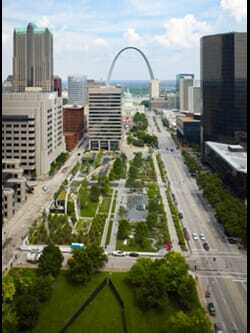Watch Amanda Burden in a video in which she discusses the value of urban open space, why she created the Amanda Burden Urban Open Space Award and more.
| Amanda Burden |
The creation of urban open space is increasingly recognized and accepted as a value generator for real estate. At ULI’s 2011 Fall Meeting in Los Angeles late last month, a panel of experts—led by New York City planning commissioner Amanda M. Burden—explored the connection between parks and real estate value, explaining the planning, design, and management techniques for creating successful urban parks. The panel also stressed the transformative effect these open spaces can have on their cities. Burden, leading off the panel, echoed the words of her mentor, renowned urbanologist Holly Whyte: “You can measure the health of a city by the vitality and energy of its public open spaces.”
To illustrate their point, the panel used the example of Citygarden, the 2011 winner of the ULI Amanda Burden Urban Open Space Award that has been heralded as “the most significant development to take place in St. Louis since the competition of the Gateway Arch nearly 50 years ago,” according to Mayor Francis Slay. Warren Byrd, lead designer of the park, described the park—a 2.9-acre (1.1-ha) rectilinear open space that comprises a sculpture garden with interactive art, imaginative and whimsical water features, and dining and picnicking venues—as “a source of discoveries and delights on an everyday basis.”
| Citygarden, Downtown St. Louis |
This vision was not realized easily, however. For nearly a century, St. Louis’s Gateway Mall, a 1.1-mile (1.8-km) ribbon of grass and trees that unfurls westward from the Gateway Arch, held the potential to be a grand civic space. That potential, however, had been left unfulfilled: the mall has long been devoid of interest and people—one panelist referred to it as a “smoke-break area” for surrounding businesses—and has been a hindrance to downtown development. Despite the long odds, the Gateway Foundation—a nonprofit organization led by Peter Fisher and dedicated to supporting efforts to acquire, create, or improve art and urban design—managed to transcend the issues that had bedeviled the site over the years. The foundation contributed $25 million, not including the cost of the sculptures, to build the city-owned park.
The panel noted that successful urban open spaces take advantage of their geographic and historic context. Citygarden was tailored to the St. Louis area: its landscaping draws on the chief natural feature of the area—its rivers—as well as on the site’s cultural history. Its limestone arc wall, which is 550 feet (179 m) long, evokes the Mississippi’s and Missouri’s limestone bluffs; the serpentine seat wall—1,100 feet (335 m) long—mirrors the course of the river itself. The hill on the site’s northwest corner references the Native American burial mounds that once dotted the local landscape, and pathways follow old city alleyways and property lines.
Public open space also has the potential to catalyze investment and boost real estate value in surrounding neighborhoods. Panelist Dan Biederman’s 34th Street Partnership oversaw the redevelopment of Herald and Greeley Square in New York, which has seen office rents rise from $30 per square foot ($322.58 per sq m) in 1999 to $45 per square foot ($483.87 per sq m) in 2009 in the blocks immediately surrounding the park. Citygarden has also had a positive effect on the surrounding real estate market and businesses. Although the St. Louis market remains sluggish, local brokers and management companies indicate that the park is considered a strong amenity and a contributing factor to high occupancy rates. Local shops and ground-floor retail establishments have benefited from the increased foot traffic, a sign that Citygarden is producing more than “island visits”—economic development parlance for users who visit a venue and then return home—and thus contributing to the vitality of downtown.
| Before and After of Citygarden St. Louis, Missori. 2011 ULI Amanda Burden Urban Open Space Award winner |
As Mark Johnson, president of Civitas, noted: “social engagement is the biggest force we can unleash to effect city development.” Successful open spaces—Citygarden, Campus Martius Park in Detroit, and Bryant Park in New York, among others—bring together people who otherwise would never meet. In an era where neighborhoods remain segregated and workplaces are isolated and stratified, public open spaces serve as the forum where people of different ages, backgrounds, and incomes interact. These “urban parlors” not only offer equal access for recreation and respite, but also can ensure the vitality of cities. As Burden concluded, it’s important for civic leaders, developers, and designers to remember the following: “Cities are not about building, they’re about people.”






